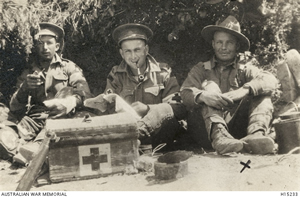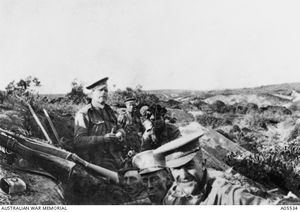English Stage 5
Overview

The first field dressing station of the 7th Battalion, AIF, Gallipoli, Turkey 25 April 1915
©Public domain (AWM H15233)
Using the documentary Archdukes, Cynicism and World War I: Crash Course World History #36, students analyse the techniques documentary makers use to engage their audience. Students write an analysis of two moments in the documentary when Green uses humour as a way of engaging his audience.
Students use the texts Archdukes, Cynicism and World War I: Crash Course World History #36, The Soldier by Rupert Brooke and The Hero by Siegfried Sassoon to examine ways in which writers were influenced by the events of the First World War. Students write a response explaining influences on writers.
Teaching and learning activities

Members of 13th Battalion, AIF, occupying Quinn's Post on the heights above Anzac Cove, 25 April 1915
©Public Domain (AWM A05534)
Activity 1 – How do documentary makers engage their audience?
Resource: Archdukes, Cynicism and World War I: Crash Course World History #36 (11:44)
-
Before viewing, ask students to brainstorm answers to the following questions:
-
What type of visuals do you expect to see in a documentary about the First World War?
-
What type of audio do you expect?
-
-
Direct students to the ‘total views’ and likes/dislikes section beneath the video. Ask them to consider what this information tells us about the documentary and how it might affect our perception of it.
-
Play the clip.
-
As a class, students identify the visual and audio aspects that they did not anticipate would be a part of the documentary. They personally nominate the two most engaging aspects of the audio and/or visuals and explain why these held their attention.
-
Ask students to share general examples of humour in the documentary and follow up these examples by asking how technical aspects construct this humour.
-
Play the clip again, and have students write an analysis of two moments in the documentary when Green uses humour as a way of engaging his audience. This analysis should include reference to audio and visual aspects from both examples.
-
Students share their responses with the class.
-
As a class, students discuss the following questions:
-
What aspects of the documentary make it suitable for publication on YouTube?
-
Who are John Green’s target audience and how is this evident in the format and style of the clip?
-
Has Green successfully engaged you as a responder? Why or why not?
-
Activity 2 – How were writers influenced by the events of the First World War?
Resources:
Archdukes, Cynicism and World War I: Crash Course World History #36 (11:44)
The Soldier by Rupert Brooke
The Hero by Siegfried Sassoon
-
Students read The Soldier and consider how Brooke is trying to represent the act of individuals fighting in war. Discuss these answers as a class and have students consider the date of the poem’s publication.
-
Screen the clip, asking students to record key phrases that reinforce the contextual relevance of the sentiment being expressed in The Soldier.
-
Discuss these answers as a class, focussing on examples from the clip.
-
Students read The Hero and consider how Sassoon’s representation of soldiers and war differs from Brooke’s, citing three examples.
-
Screen the clip again, asking students to record key phrases that describe the shift in perspective they can see in Sassoon’s work.
-
Discuss these answers as a class, focussing on examples from the clip. (Make sure to consider the irony of Sassoon’s title.)
-
Students write a brief response to the following question, making detailed reference to both poems and the clip:
How were writers influenced by the events of the First World War?
‘World War I changed our outlook, it normalised cynicism and irony, which I think you’ll agree, are the dominant lenses for describing our world today.’
‘… and how they wrote about the war really changed our relationship with systemic violence.’
‘All of these terrible outcomes led to a general sense of disappointment in literary circles, and this feeling of pointlessness and cynicism was expressed by the writers of the “lost generation”… we see this shift in the writing and art that emerged from the Great War as artists transitioned from Romanticism to Modernism.’
John Green, Archdukes, Cynicism, and World War I: Crash Course World History #36
Learning concepts
These additional questions can be used for discussion or further investigations.
Challenge
What techniques do documentary makers use to engage their audiences?
Change
How were writers influenced by the events of the First World War?
Community
How are sentiments about the First World War expressed and shared by writers?
Syllabus links
Activity 1
EN5-1A responds to and composes increasingly sophisticated and sustained texts for understanding, interpretation, critical analysis, imaginative expression and pleasure
-
appreciate, explain and respond to the aesthetic qualities and the power of language in an increasingly sophisticated range of texts
-
analyse and explain the ways language forms and features, ideas, perspectives and originality are used to shape meaning
EN5-2A effectively uses and critically assesses a wide range of processes, skills, strategies and knowledge for responding to and composing a wide range of texts in different media and technologies
-
understand that authors innovate with text structures and language for specific purposes and effects
EN5-4B effectively transfers knowledge, skills and understanding of language concepts into new and different contexts
-
recognise different uses of visual texts, media and multimedia, including the internet, eg browsing the web to locate information, using the internet to communicate socially or professionally, watching a documentary to gain knowledge and/or pleasure
Activity 2
EN5-1A responds to and composes increasingly sophisticated and sustained texts for understanding, interpretation, critical analysis, imaginative expression and pleasure
-
analyse and explain the ways language forms and features, ideas, perspectives and originality are used to shape meaning
EN5-7D understands and evaluates the diverse ways texts can represent personal and public worlds
-
evaluate the ways personal perspective and language choices affect meaning and can be shaped by social, cultural and historical influences